前言
前面已经学习了如何使用Spring与Struts2进行整合,本博文主要讲解如何使用Spring对Hibernate进行整合
Spring和Hibernate整合的关键点:
- SessionFactory对象交给Spring来创建
- Hibernate的事务交给Spring进行管理
Spring和Hibernate整合步骤
引入jar包
- 连接池/数据库驱动包
- Hibernate相关jar
- Spring 核心包(5个)
- Spring aop 包(4个)
- spring-orm-3.2.5.RELEASE.jar 【spring对hibernate的支持】
- spring-tx-3.2.5.RELEASE.jar 【事务相关】
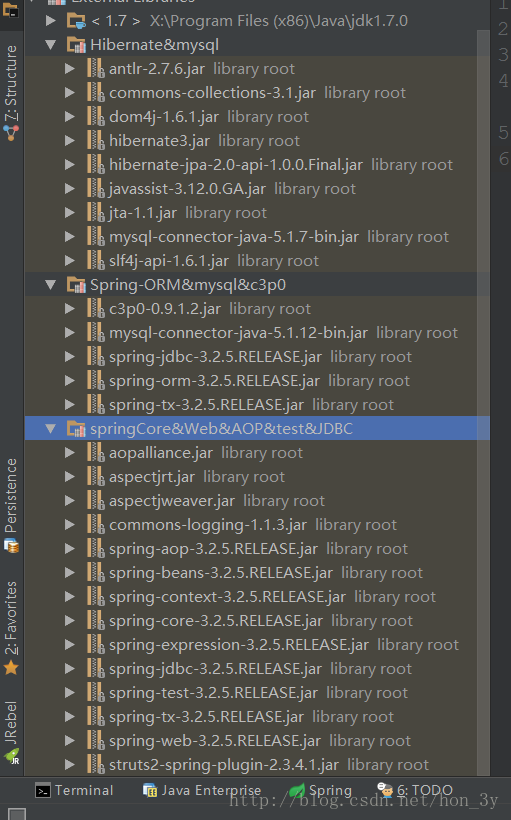
配置文件
- hibernate.cfg.xml
- bean.xml
bean.xml
1
2
3
4
5
6
| <?xml version="1.0" encoding="UTF-8"?>
<beans xmlns="http://www.springframework.org/schema/beans"
xmlns:xsi="http://www.w3.org/2001/XMLSchema-instance"
xsi:schemaLocation="http://www.springframework.org/schema/beans http://www.springframework.org/schema/beans/spring-beans.xsd">
</beans>
|
hibernate.cfg.xml
1
2
3
4
5
6
7
8
9
10
11
12
13
14
15
16
17
18
19
20
21
22
23
24
25
| <hibernate-configuration>
<session-factory>
<property name="hibernate.connection.driver_class">com.mysql.jdbc.Driver</property>
<property name="hibernate.connection.url">jdbc:mysql:///zhongfucheng</property>
<property name="hibernate.connection.username">root</property>
<property name="hibernate.connection.password">root</property>
<property name="hibernate.dialect">org.hibernate.dialect.MySQL5Dialect</property>
<property name="hibernate.show_sql">true</property>
<property name="hibernate.format_sql">true</property>
<property name="hibernate.hbm2ddl.auto">create</property>
</session-factory>
</hibernate-configuration>
|
搭建配置环境测试
1
2
3
4
5
6
7
8
9
10
11
12
13
14
15
16
17
18
19
20
21
22
23
24
25
26
27
28
29
30
31
32
33
34
35
36
37
38
39
40
41
42
43
| package bb;
public class User {
private String name;
private String password;
private int id;
public int getId() {
return id;
}
public void setId(int id) {
this.id = id;
}
public String getName() {
return name;
}
public void setName(String name) {
this.name = name;
}
public String getPassword() {
return password;
}
public void setPassword(String password) {
this.password = password;
}
@Override
public String toString() {
return "User{" +
"name='" + name + '\'' +
", password='" + password + '\'' +
'}';
}
}
|
1
2
3
| public interface IUser {
void save();
}
|
1
2
3
4
5
6
7
8
| public class UserDao implements IUser {
@Override
public void save() {
}
}
|
1
2
3
4
5
6
7
8
| public class UserService {
private UserDao userDao;
public void save() {
userDao.save();
}
}
|
测试Spring环境
首先,我们为userDao、userService使用Spring来创建对象,以及添加对象的依赖关系,看看Spring的环境是否成功
1
2
3
4
5
6
7
8
9
| @Repository
public class UserDao implements IUser {
@Override
public void save() {
}
}
|
- 创建userService实例,并注入userDao属性
1
2
3
4
5
6
7
8
9
10
| @Service
public class UserService {
@Autowired
private UserDao userDao;
public void save() {
userDao.save();
}
}
|
1
2
3
4
5
6
7
8
9
| <?xml version="1.0" encoding="UTF-8"?>
<beans xmlns="http://www.springframework.org/schema/beans"
xmlns:xsi="http://www.w3.org/2001/XMLSchema-instance"
xmlns:context="http://www.springframework.org/schema/context"
xsi:schemaLocation="http://www.springframework.org/schema/beans http://www.springframework.org/schema/beans/spring-beans.xsd http://www.springframework.org/schema/context http://www.springframework.org/schema/context/spring-context.xsd">
<context:component-scan base-package="bb"/>
</beans>
|
- 测试:成功得到userService对象,并且userService对象含有userDao属性的值
1
2
3
4
5
6
7
8
9
10
11
| public class Test2 {
@Test
public void test33() {
ApplicationContext ac = new ClassPathXmlApplicationContext("spring-config.xml");
UserService userService = (UserService) ac.getBean("userService");
System.out.println(userService);
}
}
|
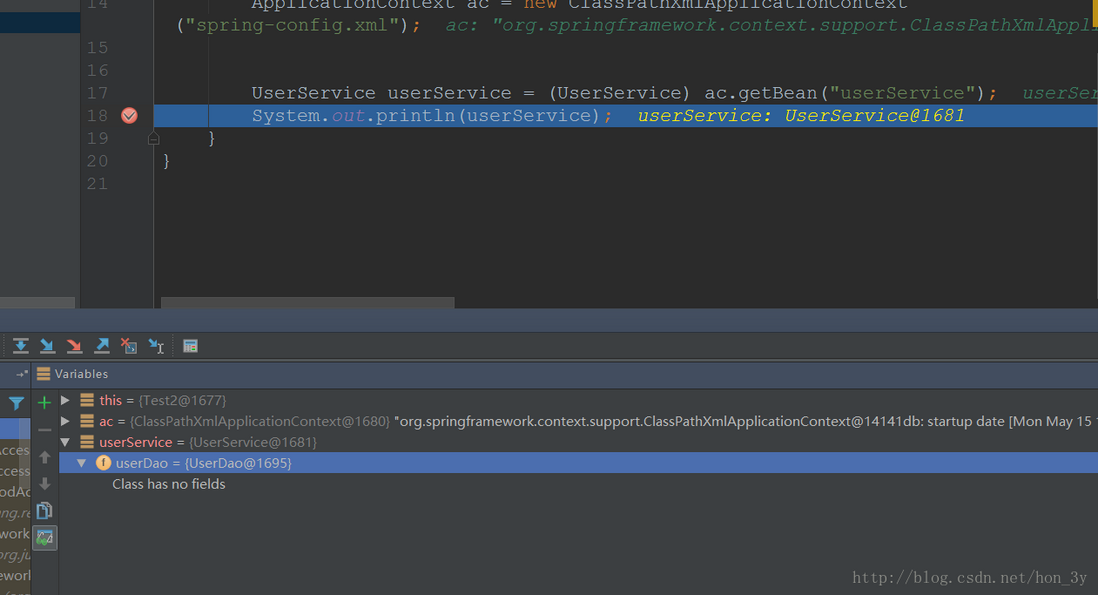
测试Hibernate环境
1
2
3
4
5
6
7
8
9
10
11
12
13
14
15
| <?xml version="1.0" encoding="UTF-8" ?>
<!DOCTYPE hibernate-mapping PUBLIC
"-//Hibernate/Hibernate Mapping DTD 3.0//EN"
"http://www.hibernate.org/dtd/hibernate-mapping-3.0.dtd">
<hibernate-mapping package="bb">
<class name="User" table="t_user">
<id name="id" column="user_id">
<generator class="native"></generator>
</id>
<property name="name" column="name"></property>
<property name="password" column="password"></property>
</class>
</hibernate-mapping>
|
1
| <mapping resource="bb/User.hbm.xml" />
|
1
2
3
4
5
6
7
8
9
10
11
12
13
14
15
16
17
18
19
20
| @Repository
public class UserDao implements IUser {
@Override
public void save(User user) {
SessionFactory sessionFactory = new Configuration().configure().buildSessionFactory();
Session session = sessionFactory.openSession();
session.beginTransaction();
session.save(user);
session.getTransaction().commit();
session.close();
}
}
|
1
2
3
4
5
6
7
8
9
10
11
12
| public class Test2 {
@Test
public void test33() {
ApplicationContext ac = new ClassPathXmlApplicationContext("spring-config.xml");
UserService userService = (UserService) ac.getBean("userService");
userService.save(new User());
}
}
|
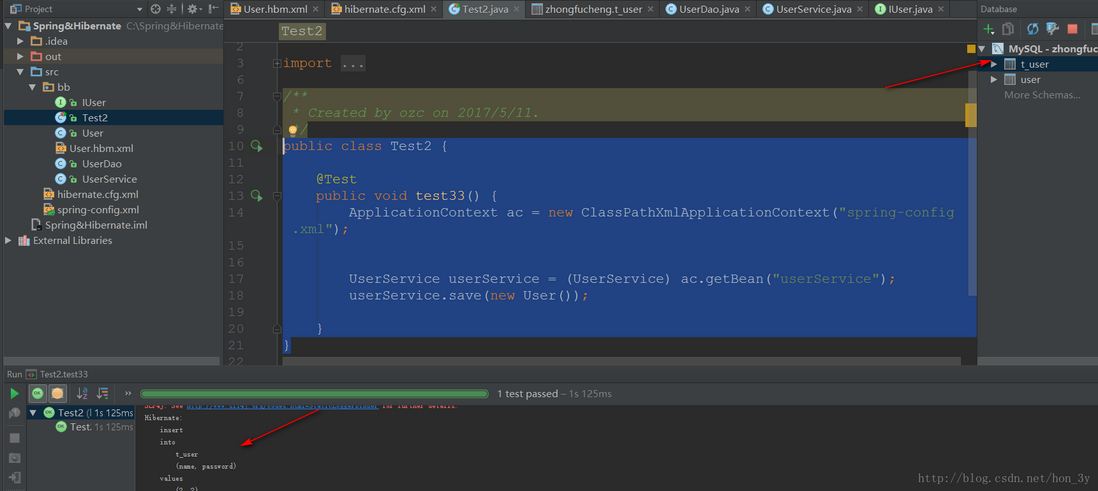
使用Spring创建SessionFactory对象
Spring与Hibernate整合的关键点之一就是使用Spring来创建SessionFactory对象。其中又有三种方式来创建SessionFactory
直接加载hibernate主配置文件
1
2
3
4
5
6
7
8
9
10
|
<bean id="sessionFactory" class="org.springframework.orm.hibernate3.LocalSessionFactoryBean">
<property name="configLocation" value="classpath:hibernate.cfg.xml"/>
</bean>
|
那么在userDao中就不用我们自己手动来创建SessionFactory对象了。
1
2
3
4
5
6
7
8
9
10
11
12
13
14
15
16
17
18
19
20
21
| @Repository
public class UserDao implements IUser {
@Autowired
private SessionFactory sessionFactory;
@Override
public void save(User user) {
Session session = sessionFactory.openSession();
session.beginTransaction();
session.save(user);
session.getTransaction().commit();
session.close();
}
}
|
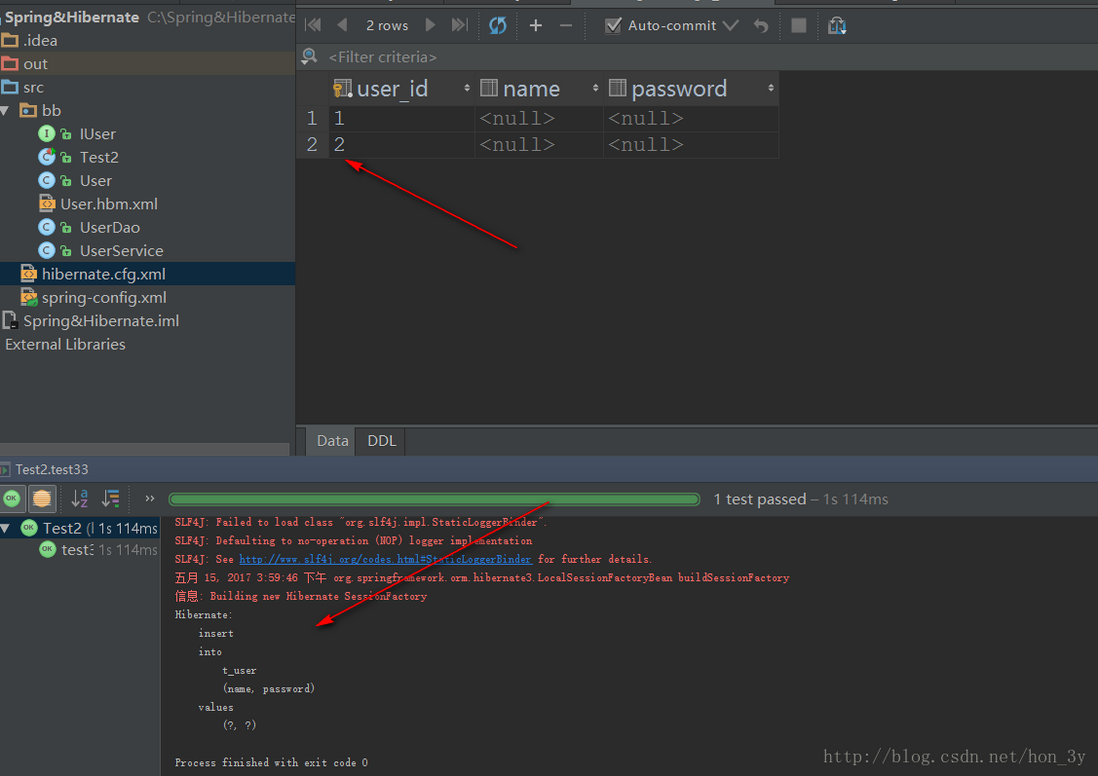
连接池交给Spring管理
我们知道Hibernate对C3P0的连接池支持度比不上Spring,因此我们可以使用Spring的连接池。因此我们加载Hibernate的主配置文件又使用Spring的数据库连接池
也就是说,一部分配置在hibernate.cfg.xml,一部分配置在Spring文件中
1
2
3
4
5
6
7
8
9
10
11
12
13
14
15
16
17
18
19
20
21
22
23
|
<bean id="dataSource" class="com.mchange.v2.c3p0.ComboPooledDataSource">
<property name="driverClass" value="com.mysql.jdbc.Driver"></property>
<property name="jdbcUrl" value="jdbc:mysql:///zhongfucheng"></property>
<property name="user" value="root"></property>
<property name="password" value="root"></property>
<property name="initialPoolSize" value="3"></property>
<property name="maxPoolSize" value="10"></property>
<property name="maxStatements" value="100"></property>
<property name="acquireIncrement" value="2"></property>
</bean>
<bean id="sessionFactory" class="org.springframework.orm.hibernate3.LocalSessionFactoryBean">
<property name="configLocation" value="classpath:hibernate.cfg.xml"/>
<property name="dataSource" ref="dataSource"/>
</bean>
|
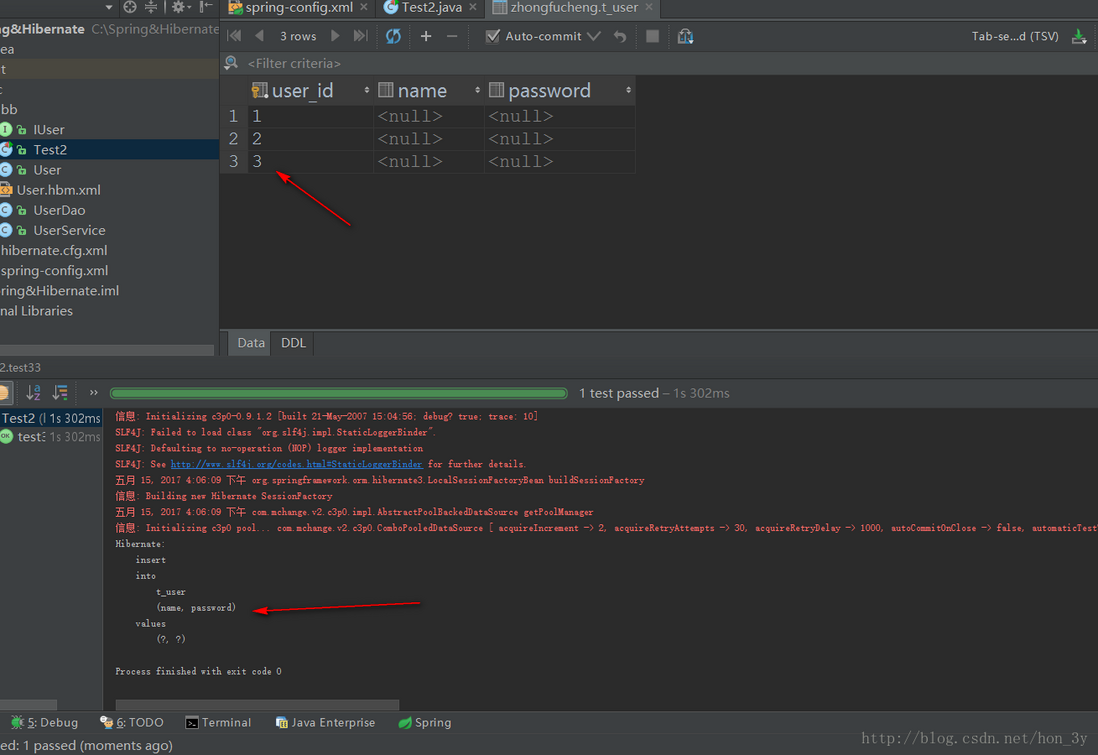
配置文件全写Spring中【推荐】
上面我们一部分是加载Hibernate的主配置文件,一部分是使用Spring配置文件的数据库连接池…这样不好…我们应该在Spring中对其进行同一的管理!
1
2
3
4
5
6
7
8
9
10
11
12
13
14
15
16
17
18
19
20
21
22
23
24
25
26
27
28
29
30
31
32
33
34
35
36
37
38
39
40
41
42
43
44
45
46
47
48
49
50
51
52
53
54
55
56
| <?xml version="1.0" encoding="UTF-8"?>
<beans xmlns="http://www.springframework.org/schema/beans"
xmlns:xsi="http://www.w3.org/2001/XMLSchema-instance"
xmlns:context="http://www.springframework.org/schema/context"
xsi:schemaLocation="http://www.springframework.org/schema/beans http://www.springframework.org/schema/beans/spring-beans.xsd http://www.springframework.org/schema/context http://www.springframework.org/schema/context/spring-context.xsd">
<bean id="dataSource" class="com.mchange.v2.c3p0.ComboPooledDataSource">
<property name="driverClass" value="com.mysql.jdbc.Driver"></property>
<property name="jdbcUrl" value="jdbc:mysql:///zhongfucheng"></property>
<property name="user" value="root"></property>
<property name="password" value="root"></property>
<property name="initialPoolSize" value="3"></property>
<property name="maxPoolSize" value="10"></property>
<property name="maxStatements" value="100"></property>
<property name="acquireIncrement" value="2"></property>
</bean>
<bean id="sessionFactory" class="org.springframework.orm.hibernate3.LocalSessionFactoryBean">
<property name="dataSource" ref="dataSource"/>
<property name="hibernateProperties">
<props>
<prop key="hibernate.dialect">org.hibernate.dialect.MySQLDialect</prop>
<prop key="hibernate.show_sql">true</prop>
<prop key="hibernate.hbm2ddl.auto">update</prop>
</props>
</property>
<property name="mappingLocations">
<list>
<value>bb/User.hbm.xml</value>
</list>
</property>
</bean>
<context:component-scan base-package="bb"/>
</beans>
|
我们推荐的就是使用这一种,就可以少了Hibernate的配置文件了。并且容易统一管理。
Spring管理事务
到目前为止,我们是使用Hibernate编程式事务控制管理,Spring与Hibernate整合另一个关键就是使用Spring对Hibernate进行事务管理
1
2
3
4
5
6
7
8
9
|
<bean id="txManager" class="org.springframework.orm.hibernate3.HibernateTransactionManager">
<property name="sessionFactory" ref="sessionFactory"/>
</bean>
<tx:annotation-driven transaction-manager="txManager"/>
|
值得注意的是:Spring与Hibernate整合,Spring只支持线程的Session,并且不用我们手动配置
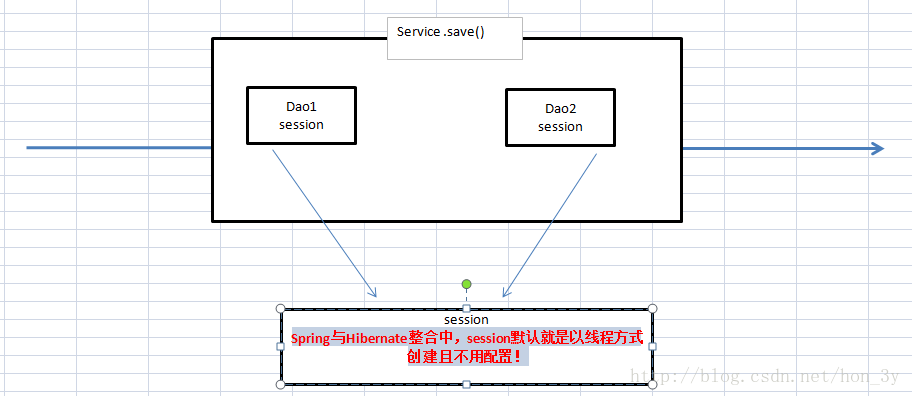
userDao
1
2
3
4
5
6
7
8
9
10
11
12
13
| @Repository
public class UserDao implements IUser {
@Autowired
private SessionFactory sessionFactory;
@Override
public void save(User user) {
sessionFactory.getCurrentSession().save(user);
}
}
|
userService添加@Transactional注解就是为Hibernate添加了事务管理了。
1
2
3
4
5
6
7
8
9
10
11
| @Service
@Transactional
public class UserService {
@Autowired
private UserDao userDao;
public void save(User user) {
userDao.save(user);
}
}
|





